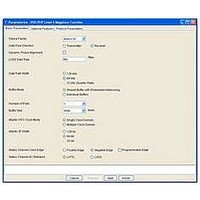IP-POSPHY4 Altera, IP-POSPHY4 Datasheet - Page 36

IP-POSPHY4
Manufacturer Part Number
IP-POSPHY4
Description
IP CORE - POS-PHY Level 4 SPI 4.2 Interface
Manufacturer
Altera
Type
MegaCorer
Datasheet
1.IP-POSPHY4.pdf
(144 pages)
Specifications of IP-POSPHY4
Software Application
IP CORE, Interface And Protocols, COMMUNICATION
Supported Families
Arria GX, Cyclone, HardCopy, Stratix
Core Architecture
FPGA
Core Sub-architecture
Arria, Cyclone, Stratix
Rohs Compliant
NA
Function
POS-PHY Level 4 Interface, Link-Layer/PHY Layer
License
Initial License
Lead Free Status / RoHS Status
na
Lead Free Status / RoHS Status
na
- Current page: 36 of 144
- Download datasheet (3Mb)
3–14
POS-PHY Level 4 MegaCore Function User Guide
Transmitter Options
f
1
1
For individual buffers far-end transmitter variations, changing calendars does not
cause the credit table to be flushed, thus a port may not immediately be disabled if it
still has credits. It is up to the user logic to flush the receiver and transmitter buffers
prior to changing the calendar-select word. Otherwise, data may become stranded.
Each calendar can have independent values for calendar length and calendar
multiplier.
The Burst unit size sets the unit size in bytes for burst transfers and controls the
smallest burst transmitted. The valid range for this parameter is from 16 to 1,024
bytes, in 16-byte granularity.
The burst unit size multiplier does not limit the maximum burst length, and does not
force control word insertion. Instead, use the Burst limit parameter.
When the data path width is equal to 128 bits and the lite transmitter feature is turned
off, the unit size is 32 bytes, up to 1,024 bytes in 32-byte granularity.
The MaxBurst1 parameter allows you to select the maximum number of credits—
burst unit size to 2,032 bytes—that can be transmitted when the adjacent device’s
FIFO buffer is starving.
The MaxBurst2 parameter allows you to select the maximum number of credits—
burst unit size to 2,032 bytes—that can be transmitted when the adjacent device’s
FIFO buffer is hungry.
The MaxBurst1 and MaxBurst2 parameters do not limit the maximum burst length,
and do not force control word insertion.
The MaxBurst1 and MaxBurst2 parameters are used by the transmit scheduler, thus
they apply only to the individual buffers mode.
MaxBurst2 must be less than or equal to MaxBurst1; MaxBurst1 and MaxBurst2 must
be greater than or equal to burst unit size.
Refer to
You can enter the Burst limit only when you turn on Burst Limit Enable. The Burst
limit sets the maximum burst size, in bytes, to be sent by the transmitter, and
guarantees that the transmitter does not send bursts longer than the burst limit (a
control word is inserted at the end of the burst limit). Burst limit values are restricted
to multiples of burst unit size. Depending on other transmitter parameters, the values
may be limited to a minimum value. IP Toolbench only allows valid burst limit
values.
The Maximum training sequence interval (MaxT) allows you to select the interval at
which the training sequence occurs—16 to 65,535 bytes. The training sequence is
scheduled to be inserted after the MaxT counter expires, but is not actually inserted
until the burst that is sent is complete. Therefore, the time between training pattern
insertions is no less than the value of the MaxT parameter, and no more than the value
of the MaxT parameter plus the burst unit size.
Figure 3–5 on page 3–16
for the relation of AE and AF.
December 2010 Altera Corporation
Chapter 3: Parameter Settings
Protocol Parameters
Related parts for IP-POSPHY4
Image
Part Number
Description
Manufacturer
Datasheet
Request
R

Part Number:
Description:
IP CORE Renewal Of IP-POSPHY4
Manufacturer:
Altera
Datasheet:

Part Number:
Description:
IP Thermal Transfer Printer With Peel/Present Option
Manufacturer:
BRADY

Part Number:
Description:
CYCLONE II STARTER KIT EP2C20N
Manufacturer:
Altera
Datasheet:

Part Number:
Description:
CPLD, EP610 Family, ECMOS Process, 300 Gates, 16 Macro Cells, 16 Reg., 16 User I/Os, 5V Supply, 35 Speed Grade, 24DIP
Manufacturer:
Altera Corporation
Datasheet:

Part Number:
Description:
CPLD, EP610 Family, ECMOS Process, 300 Gates, 16 Macro Cells, 16 Reg., 16 User I/Os, 5V Supply, 15 Speed Grade, 24DIP
Manufacturer:
Altera Corporation
Datasheet:

Part Number:
Description:
Manufacturer:
Altera Corporation
Datasheet:

Part Number:
Description:
CPLD, EP610 Family, ECMOS Process, 300 Gates, 16 Macro Cells, 16 Reg., 16 User I/Os, 5V Supply, 30 Speed Grade, 24DIP
Manufacturer:
Altera Corporation
Datasheet:

Part Number:
Description:
High-performance, low-power erasable programmable logic devices with 8 macrocells, 10ns
Manufacturer:
Altera Corporation
Datasheet:

Part Number:
Description:
High-performance, low-power erasable programmable logic devices with 8 macrocells, 7ns
Manufacturer:
Altera Corporation
Datasheet:

Part Number:
Description:
Classic EPLD
Manufacturer:
Altera Corporation
Datasheet:

Part Number:
Description:
High-performance, low-power erasable programmable logic devices with 8 macrocells, 10ns
Manufacturer:
Altera Corporation
Datasheet:

Part Number:
Description:
Manufacturer:
Altera Corporation
Datasheet:

Part Number:
Description:
Manufacturer:
Altera Corporation
Datasheet:











